Earlier in December 2021 Comet C/2021 A1 Leonard lured bleary-eyed northern hemisphere comet observers out of their beds before sunrise, eager to watch it drop past the stars of the Big Dipper and then fall past Arcturus.
Although the comet was much smaller and much fainter than the most recent bright comet, Comet Neowise, A1 Leonard was still a very attractive sight in binoculars and looked fantastic on guided, long-exposure photos, with a glowing green head and a straight tail that stretched between two and ten degrees long (depending on which report you read).
By 10 December the comet’s tail was beginning to appear to fan out, due to our changing line-of-sight from Earth, but it had dropped so far south that it was hard for observers at mid-northern latitudes to see.
Read more:

Although some optimistic comet watchers tried to spot it low in the north west after sunset, very few managed to, and a couple of days later we – reluctantly – admitted defeat and handed the comet over to our counterparts at lower northern latitudes and in the southern hemisphere.
Since then southern observers have reported the comet has remained easily visible in binoculars and small telescopes, and one report even had it reaching magnitude 2.5 (although that has been challenged).
What is certain is that the comet is bright enough to photograph in the evening twilight from locations further south than the UK, appearing as a 'star' surrounded by a glowing almost golden halo, due to the fact that we are now effectively looking straight at the comet head-on as it passes us.
Over the next few days southern observers are hoping to see the comet’s tail return to view as our viewing angle changes and the comet slides past Venus in their evening sky.
No doubt some observers in the north will try to photograph it too, so good luck to you if you’re one of them!
In an ideal world the comet will now develop a fan-shaped tail, making it a very attractive photographic target, but we’ll have to wait and see.
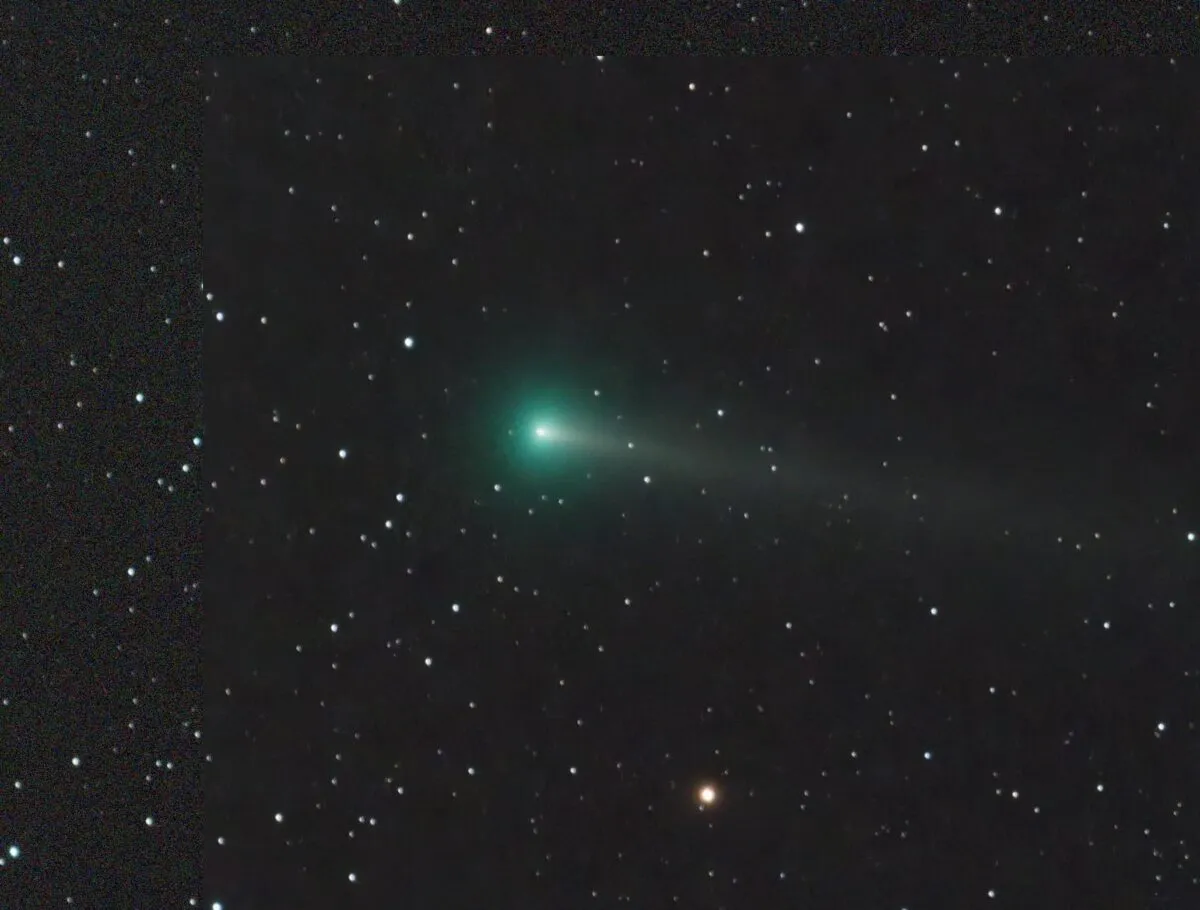
So, Comet A1 Leonard’s show is almost over. When it flies off back into deep space, many of us will have fond memories of getting up at you’re-having-a-laugh-o’clock to see it glowing above nearby treetops and roofs.
Many others will recall only frustration as bad weather prevented them from ever seeing it.
Some observers have said that Comet A1 Leonard was “disappointing”, even calling it a “tiddler” rather unkindly, but that’s not very fair.
Comets as bright as Leonard don’t come along very often, and most of the comets that appear in our sky never become bright or big enough to see without a telescope, and then they only look like fuzzy, out of focus stars.
Comet Neowise definitely spoiled us!
When will the next bright comet appear? We don’t know. But right now, as you read this, there is a huge dirty iceberg somewhere out there in the cold, dark depths of the solar system that we haven’t found yet but is destined to become the next truly Great Comet, rivalling or even outshining Hale-Bopp.
It might not appear for another decade, or it might surprise us next year, we just don’t know. But it is out there, somewhere. We just have to be patient.
Find our which comets are coming up via our regularly-updated webpage What comets and asteroids are in the sky tonight?
The story of Comet Leonard
At the start of 2021, newly discovered comet C/2021 A1 Leonard was announced.
Excitingly it had the possibility of becoming bright during December 2021 and exceeding the threshold of naked-eye visibility in the run-up to Christmas.
Below is the story of Comet Leonard, as we reported it at the time.
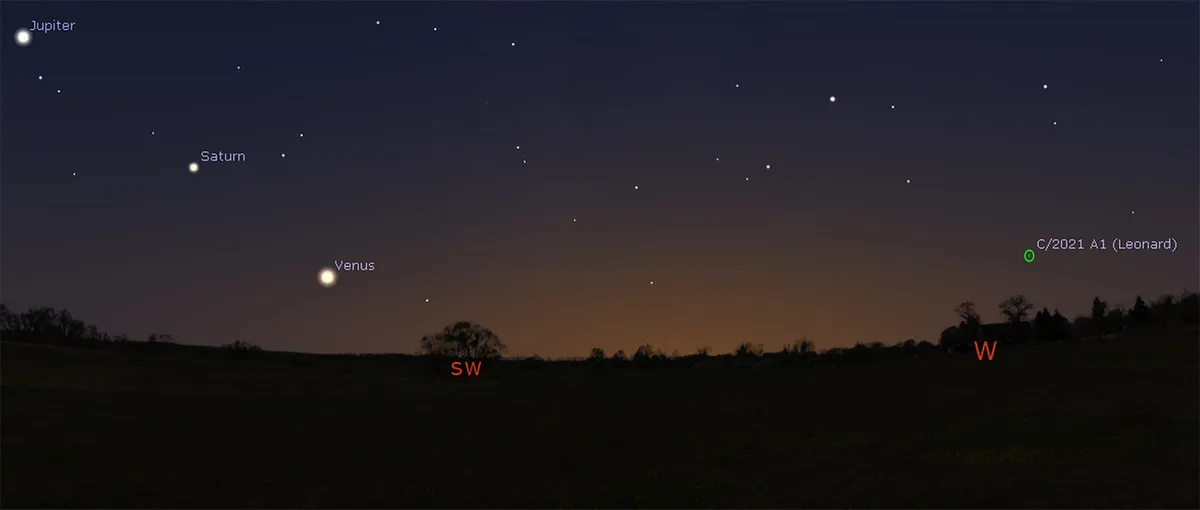
As of 9 December, Comet A1 Leonard continues to delight observers and photographers blessed with clear skies, as it falls south towards its close encounter with the Sun.
Leonard is now technically visible in both the morning and evening sky for northern observers, but the comet's low magnitude, low elevation and small size in the sky mean it is an extremely challenging target for anyone trying to see it after sunset.
By far the best views are being enjoyed by observers who get up early to spot the comet low on the east before sunrise.
There are now several reports of the comet being visible to the naked eye from dark sky sites, and social media posts show that observers around the world are enjoying good views of the comet through binoculars and small telescopes.
As far as the comet's brightness is concerned, estimates range from mag. +5 to 6.
From Kendal in Cumbria on the morning of 9 December the comet was not visible to my naked eye, and only appeared as an out of focus star with a hint of a tail through binoculars.
You can see this below in my image, which was captured from Kendall, Cumbria in the UK.
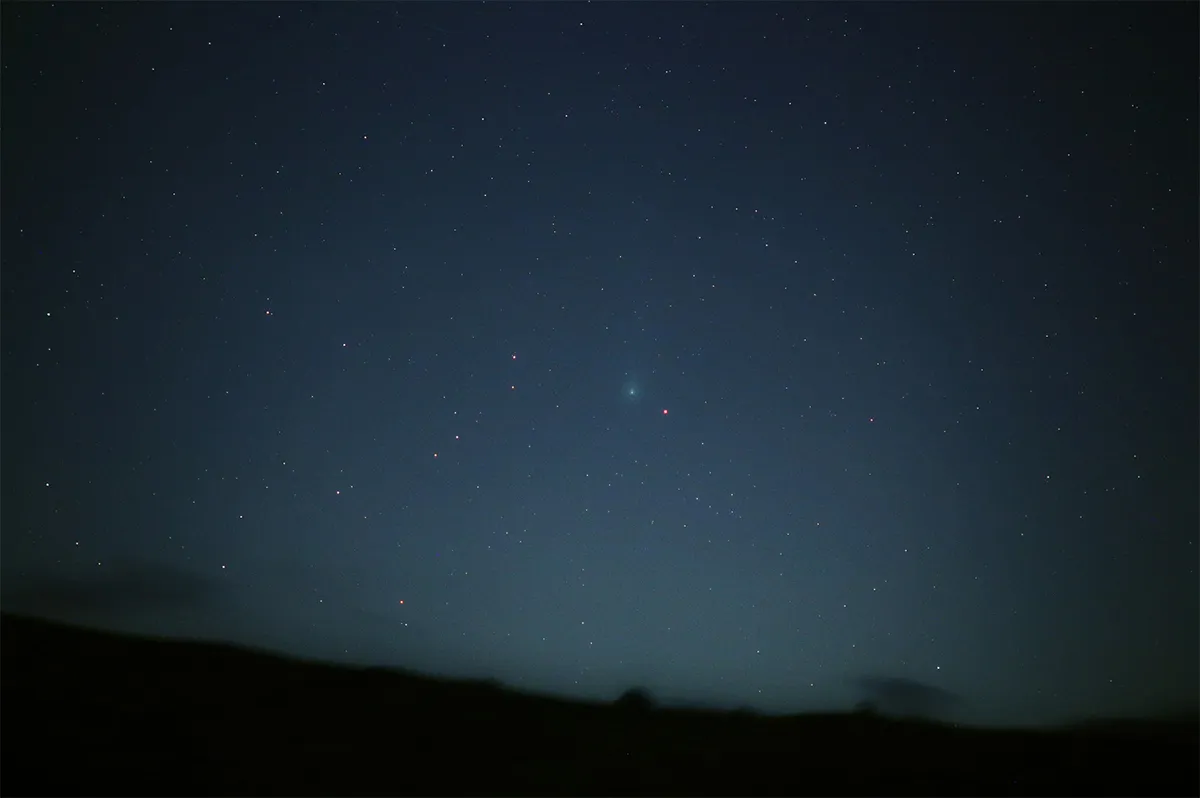
Photographically, the comet is both attractive and fascinating, with a bright, green-hued head and a long, straight tail that now stretches several degrees in length that DSLR cameras can pick up even on single, tracked exposures.
Experienced comet photographers using advanced equipment and processing techniques are recording fine detail and structure in the comet's tail, as well as a pair of bright 'jets' or 'plumes' within the coma.
The comet has now sped past the bright star Arcturus and is becoming harder to see for northern hemisphere viewers.
But as it falls towards the Sun it remains healthy, and southern hemisphere comet observers are now looking forward to it appearing in their sky.
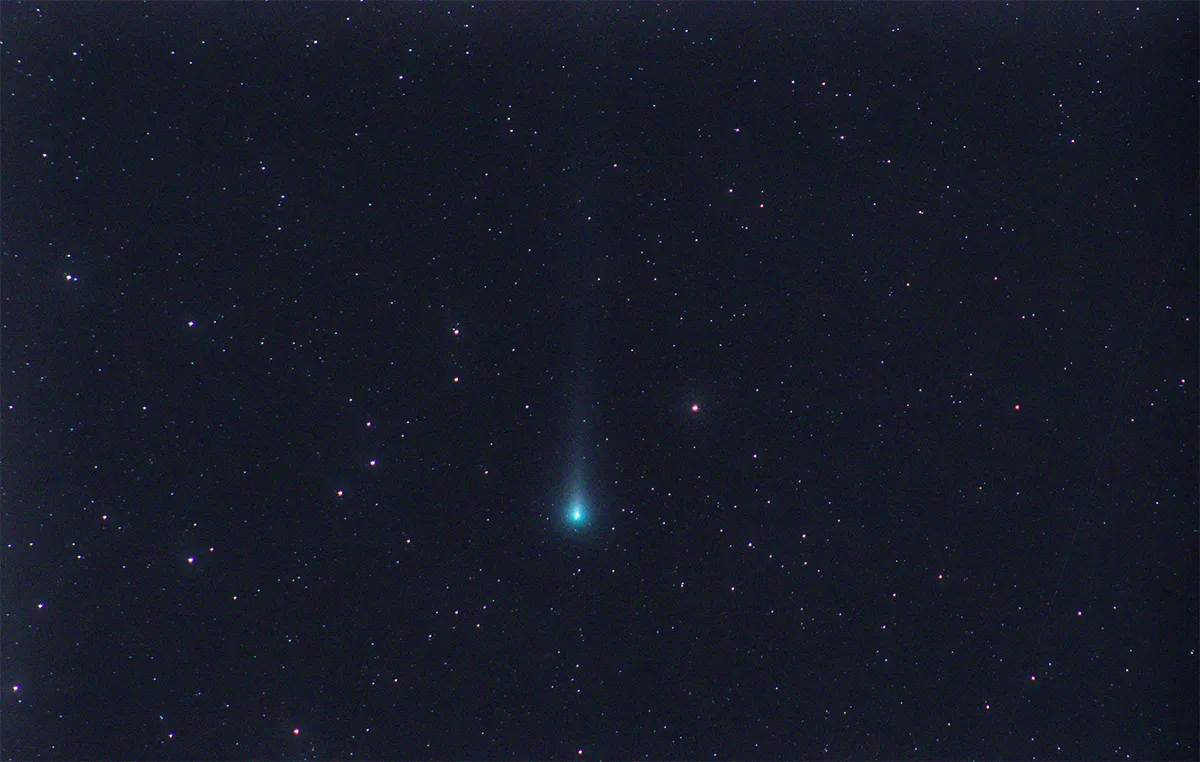
It's been great to catch a clear glimpse, because earlier in the week, around 7 December, it was a story of frustration for British comet-watchers wanting to see and photograph Comet C/Leonard.
After a couple of mornings of clear skies across almost everywhere, when many people had their first proper views of the comet, the cloud returned and prevented us from seeing Comet Leonard’s closest encounter with the beautiful globular cluster M3.
In other parts of the world blessed with clear skies, many astrophotographers took beautiful images of the comet closing in on and then passing the star cluster, and the contrast between the softly glowing green head of the comet and the salt grain-like stars of the cluster was striking.
This was captured beautifully by astrophotographer Joel Erwin (@JAErwin8), who posted his shot on Twitter.
Astrophotographers Terry Hancock and Tom Masterson captured this image of Comet A1 Leonard passing by globular cluster M3, and were surprised to find a meteor had sneaked into the frame!
The image was captured at the Grand Mesa Observatory in Colorado, USA in the early morning of 3 December 2021.
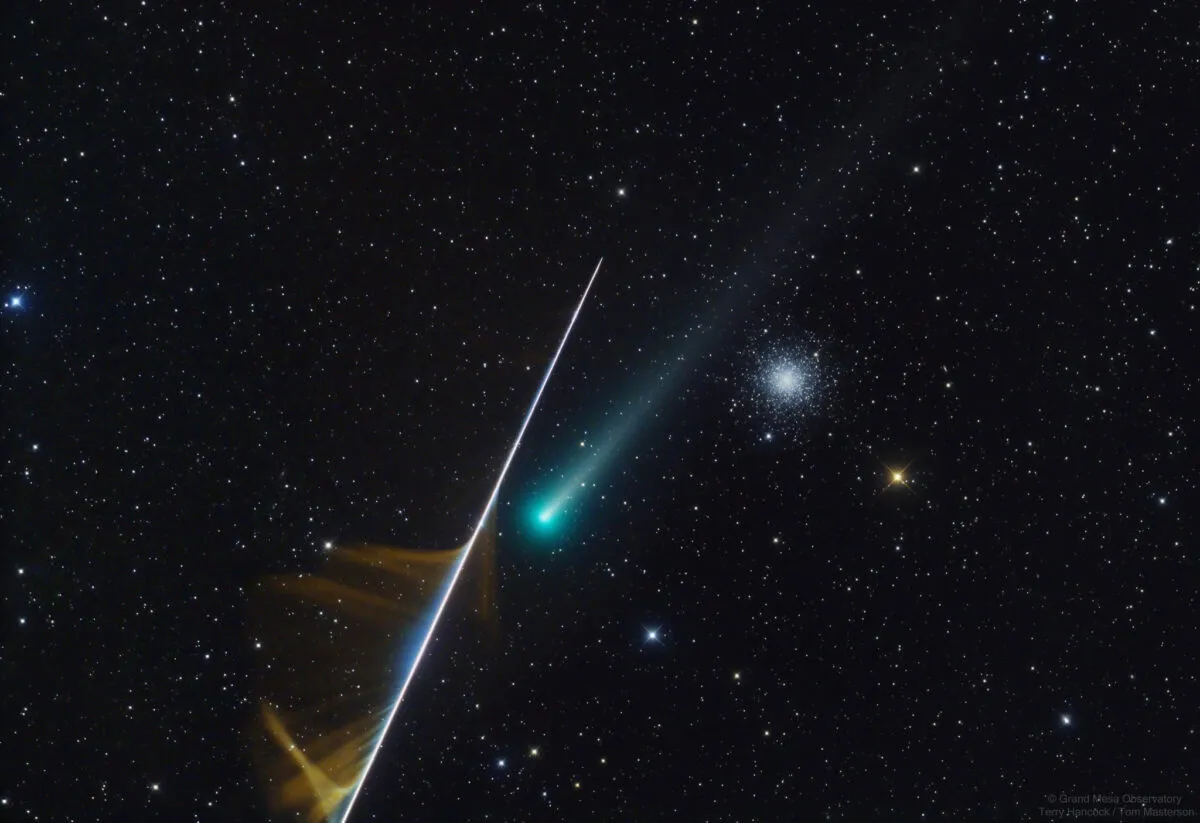
Northern observers with flat and low horizons to their north west are now heading out to look for the comet after sunset, but the time it is visible in a reasonably dark sky before it sets is short.
The comet is a real 'tree scraper' and will remain so until we lose it from view after mid-month.
The best views of the comet are still to be had in the hours before dawn, when it is high in the sky for several hours before sunrise.

So, all we can do here in the UK is hope for more breaks in the weather.
Meanwhile, observers in other parts of the world are enjoying observing this comet through their telescopes and binoculars, seeing it brighten steadily as it falls towards the Sun.
Many comet watchers are now quietly optimistic that in a week or so, when the comet is at its best, it will be visible to the naked eye, and might even grow a pretty tail.
If it does we might yet see something very attractive in our twilight sky after sunset.
But as always it’s best not to get our hopes up – comets are notoriously unpredictable and anyone making a confident prediction is very unwise indeed.
We’ll see what happens next!
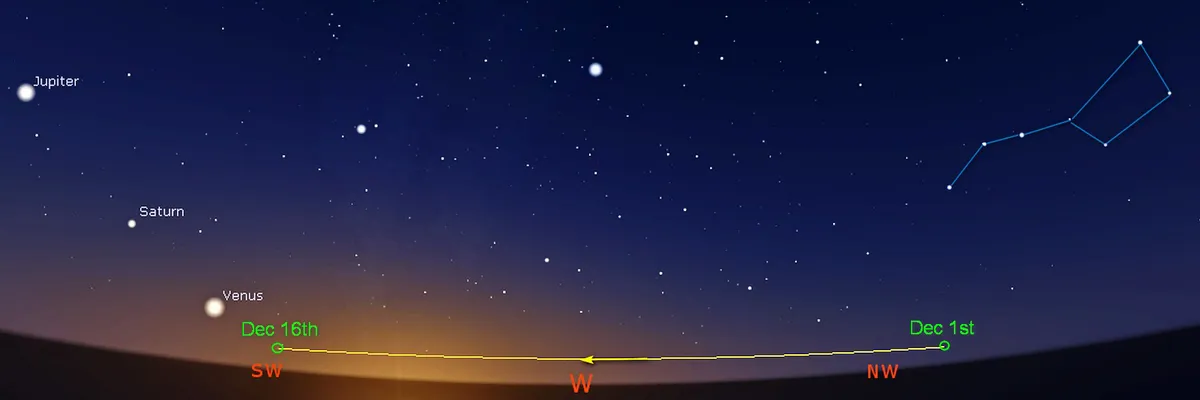
Comet Leonard: the story so far
Throughout November 2021 comet-watchers wanting to see and photograph Comet C/2021 A1 Leonard were very frustrated. The problem was the Moon.
At the end of November, just as the comet was predicted to be brightening enough to sneak it within the range of small telescopes and perhaps even binoculars, the full and then waning gibbous Moon was blazing in the same part of the sky as the comet, making it hard to see and washing out any detail in its tail and around its head.
That didn’t stop many people observing and photographing it of course.
Astrophotographer and Twitter user Paul Macklin (@MathCancer) captured a beautiful image of Comet Leonard on 28 November from his back garden in Bloomington, Indiana, United States, and posted it to his feed.
Tom Masterson and Terry Hancock collaborated to capture this image of Comet A1 Leonard from Grand Mesa Observatory in Colorado, USA.
In the image, which was captured on 25 November, the Whale Galaxy and Hockey Stick Galaxy can be seen in the background.

Everyone looking at this icy visitor from deep space couldn’t help wondering what the comet would have looked like if they could snap their fingers, turn off the Moon and see it in a dark sky…
On the morning of 2 December – after several days of cloud and rain here in the UK – we finally got our answer.
The comet is still not bright enough to see with the naked eye but it is now visible in binoculars, and has grown a small tail too, which appears a couple of degrees long in long exposure, guided photographs.
It is bright enough to photograph using a DSLR camera with even with short, unguided exposures, and images taken with motorised tracking mounts bring out the icy green hue of its head and show the tail well too.
Many observers were relieved to see the comet looking so healthy on the morning of 2 December, as you can see in my image below.
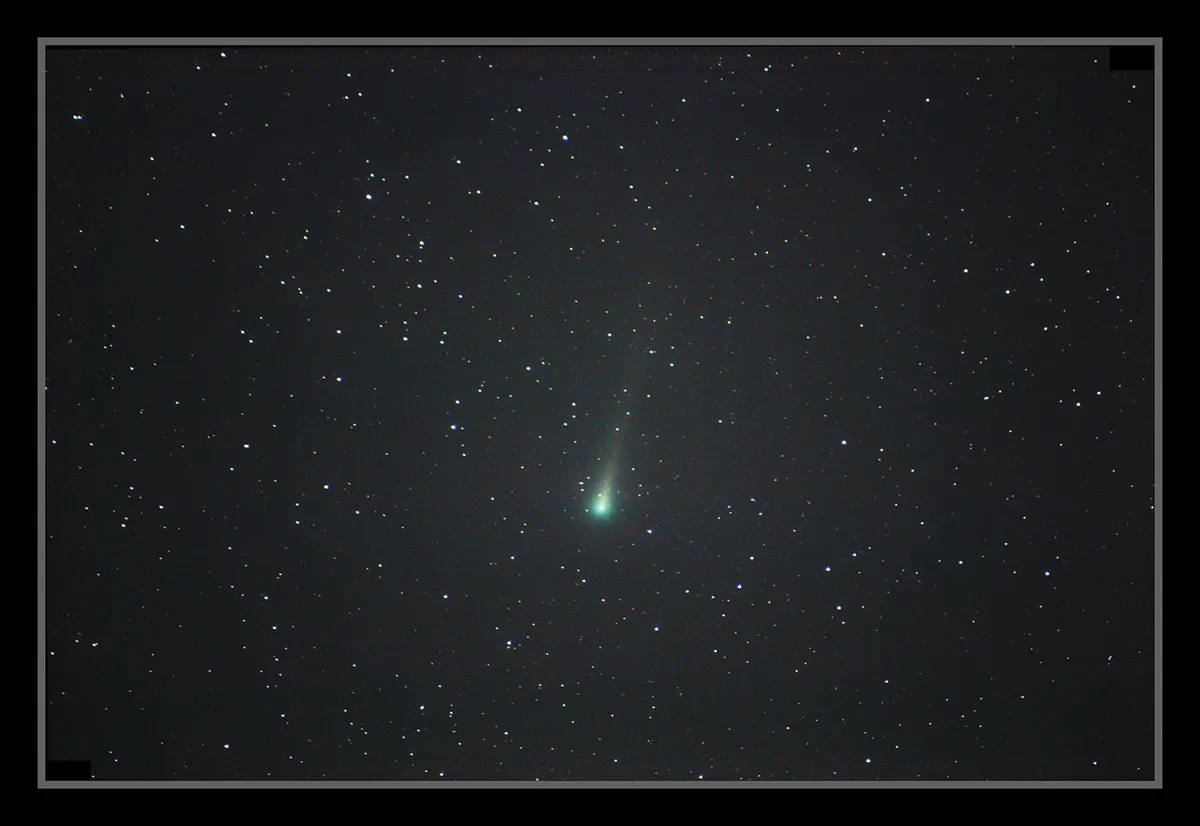
The relief was palpable. A few days ago reports were circulating on social media claiming that the comet had started to disintegrate.
These reports were based on a handful of images that appeared to show the comet’s head had developed a kind of hammerhead or anvil shape.
Why was this bad? Because when that has happened to comets in the past it has been an indicator that something bad was happening to them.
Last year several comets that had looked like they would become bright enough to see with the naked eye fizzled and fell apart after they developed these weird shapes, so there was much biting of fingernails while we waited for more detailed images to be taken.
Thankfully they showed that the comet appears healthy, and reports of its death – like most things on social media – were greatly exaggerated.
UPDATE: 21 December 2021
Having watched it drop down past the stars of the Big Dipper and then Arcturus earlier this month, observers at medium to high northern latitudes can no longer see Comet C/2021 A1 Leonard.
But for sky-watchers further south than that, and down into the southern hemisphere, this icy celestial visitor it is putting on quite a show…
It’s fair to say that when reports started to come in a couple of days ago suggesting that the comet had brightened considerably, increasing in magnitude from around 5 to almost 2, making it an easy naked eye object they triggered some eyebrow-raising.
But as more and more reports and photos came in it became clear that they were correct: the head of Comet A1 Leonard had brightened by a huge amount, almost overnight.
Not only that, but its tail had begun to grow in length and width too, transforming the comet from an out-of-focus star to a “proper comet” with a glowing head and a tail behind it.
Although it is still nowhere near as bright as Comet NEOWISE which delighted comet-watchers not too long ago, Comet Leonard is a naked eye object, and today’s photos show that it has developed into one of the most beautiful binocular and telescopic comets for years.
It is still relatively small in the sky – its tail is less than five degrees long – but it is easily visible in binoculars, and guided, long exposure photos show the tail has several distinct braids and twists within it.
How will the comet develop in the days ahead? We can’t know.
But southern hemisphere observers are already loving having a naked eye comet on their sky after sunset, and astro-photographers are enjoying imaging it too.
If you are far enough south to see the comet you should definitely get out and look for it.
You’ll find it close to Venus in the sky, and your favourite phone app or online planetarium website will show you exactly where and when you will be able to see it.
Where is Comet Leonard now?
So, Comet A1 Leonard is alive and well, and visible in the morning sky. Having passed beneath the stars of the Big Dipper it is now dropping down towards the bright star Arcturus, which it will pass between 6 and 7 December.
On the morning of 3 December the comet wafted past bright globular cluster M3, and no doubt many astrophotographers will have been out taking beautiful images of that close encounter.
Comet A1 Leonard will appear at its best around 12-14 December Dec, when it will be visible in both the morning and the evening sky too.
If your sky is clear after sunset on those nights Comet A1 Leonard will be found low in the sky, over to the right of the planet Venus, currently a bright 'Evening Star' shining in the twilight.
We’re still hopeful the comet will be a naked eye object then, and there’s even a chance that its brightness will be enhanced briefly by forward scattering of sunlight through the gas and dust in its tails.
If that happens, and if its fledgeling tail continues to grow, it might look very attractive in the dusk – we’ll just have to wait and see. Comets are famously unpredictable, but maybe Comet A1 Leonard has a surprise or two up its sleeve still…
How Comet Leonard came to prominence
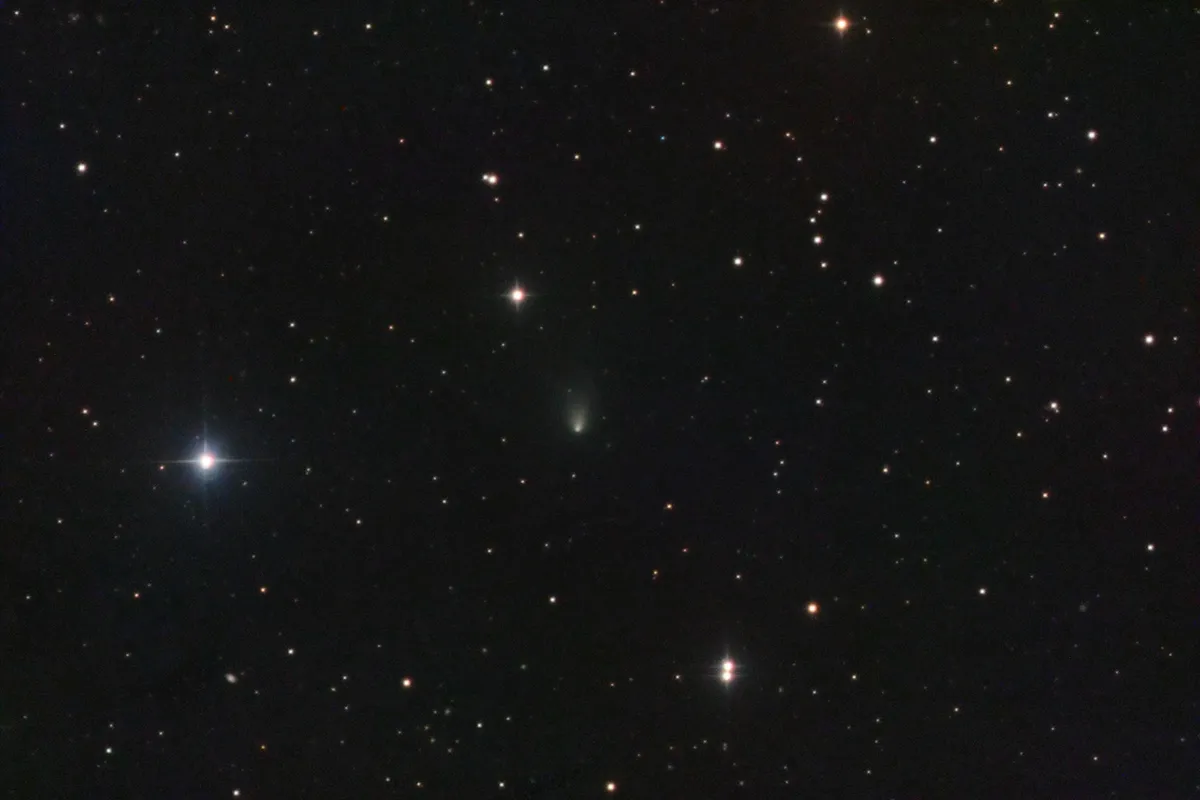
Comet Leonard was discovered by astronomer Greg Leonard at the start of 2021, and many images taken in November already showed a decent coma and tail.
This had many speculating we could see enthusiasm and interest in Comet Leonard reach a peak in December, similar to what we saw in 2020 with Comet NEOWISE, which made headlines around the globe.
Indeed, as comet-chaser José J. Chambó recorded in an image captured by him (below) on 4 November 2021 from Mayhill, New Mexico, USA, Comet Leonard has certainly shown an increase in brightness over the past month or so, especially when compared to a previous image captured by José on 5 October (above).
"Since my previous image its look changed dramatically: in just two weeks its brightness has increased from magnitude 11.5 to 10," says José of his 4 November shot.
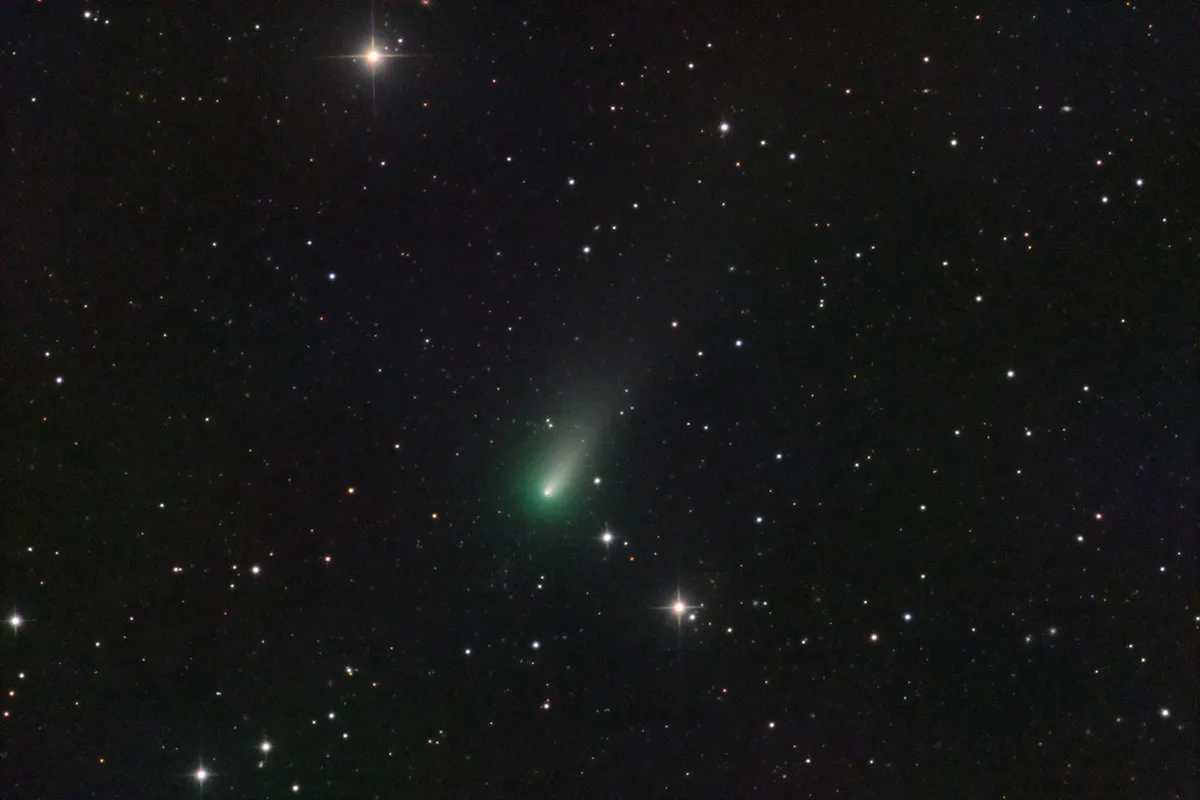
"Its coma has increased in angular size from 4' to 9' having developed a strong outer halo of intense green colour, and its tail has grown from 5' to 16' in length.
"Everything continues signalling that the comet is very active and it keeps the expectation of being observable at naked eye in December."
José then captured this image of Comet Leonard on 11 November 2021.
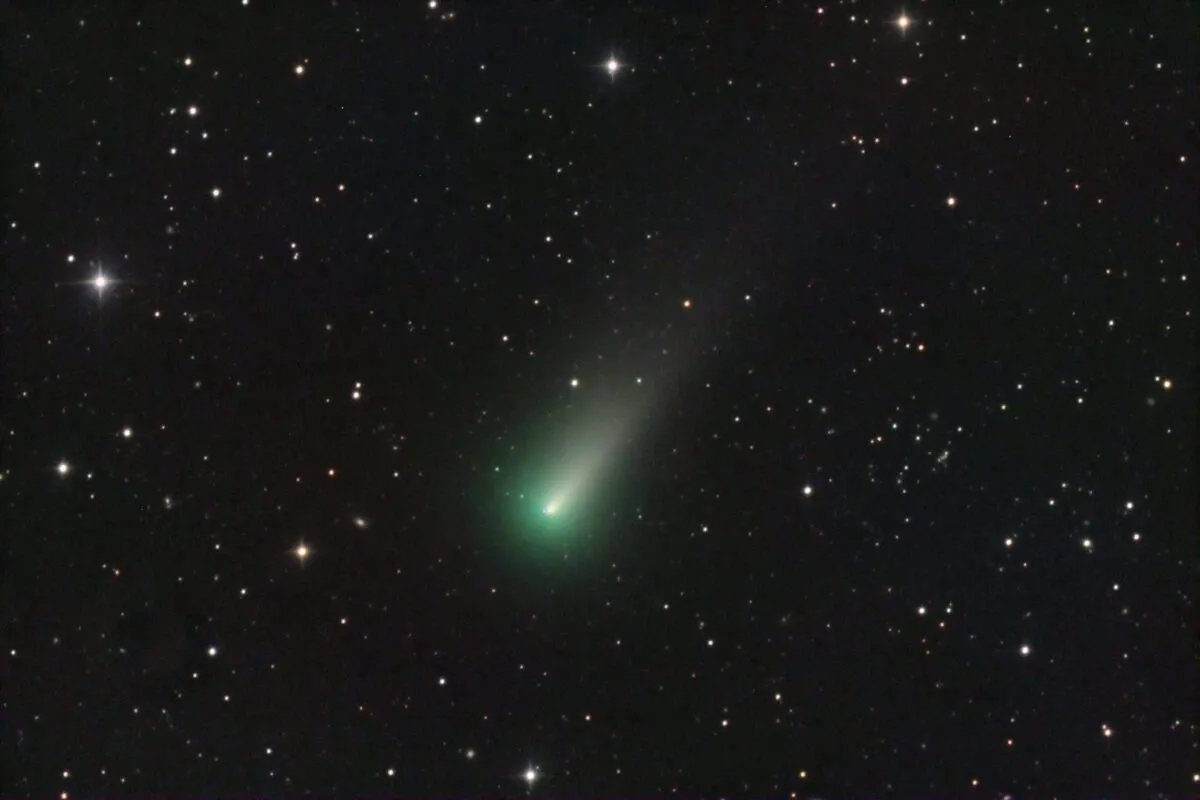
He said: "Since my image a week ago the comet has increased its brightness from magnitude 10 to 9.5 so it is already observable with small telescopes.
"Its coma has grown from 9' to 11' in angular size, while the tail has been extended from 16' to 19' in length with a narrower and sharp jet to antisunward direction."
Keep up to date with José's comet-chasing via his website Cometografía.
How to see Comet Leonard
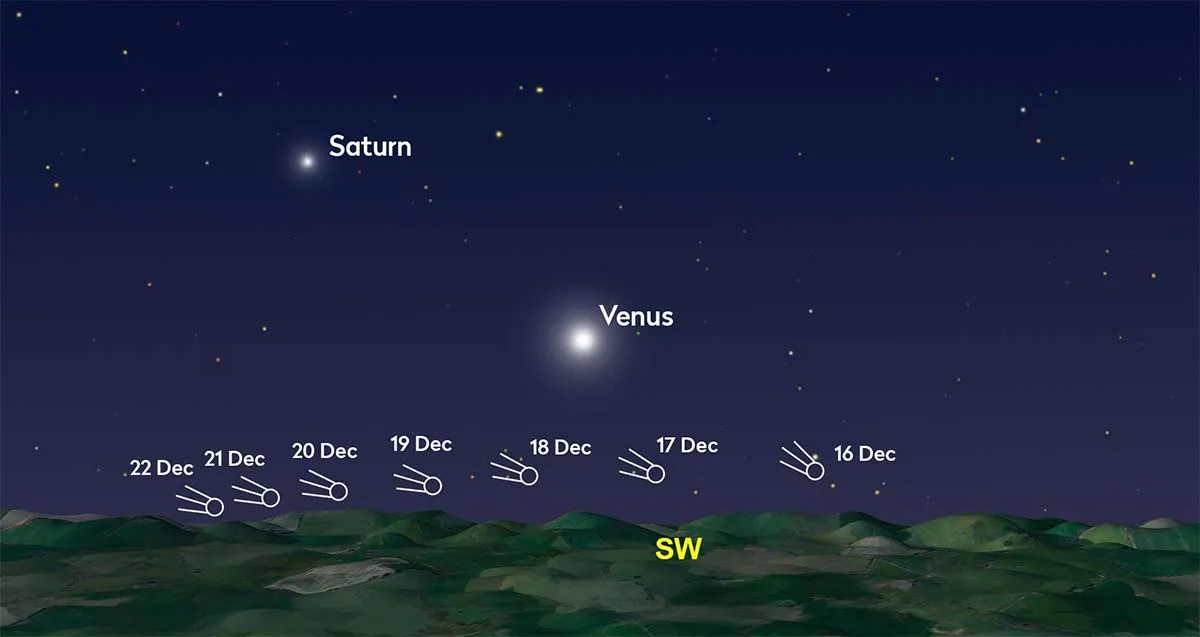
Comet Leonard was positioned near mag. +4.3 Beta (β) Comae Berenices on 1 December, shining at mag. +9.3.
It’s expected to brighten to about seventh magnitude mid-month, making it an easy object to observe through binoculars.
An effect known as forward-scattering enhancement may boost its brightness so it becomes visible to the naked eye.
Forward-scattering enhancement may help A1 Leonard become visible to the naked eye between 10–16 December, peaking at mag. +4.0 around 13 December.
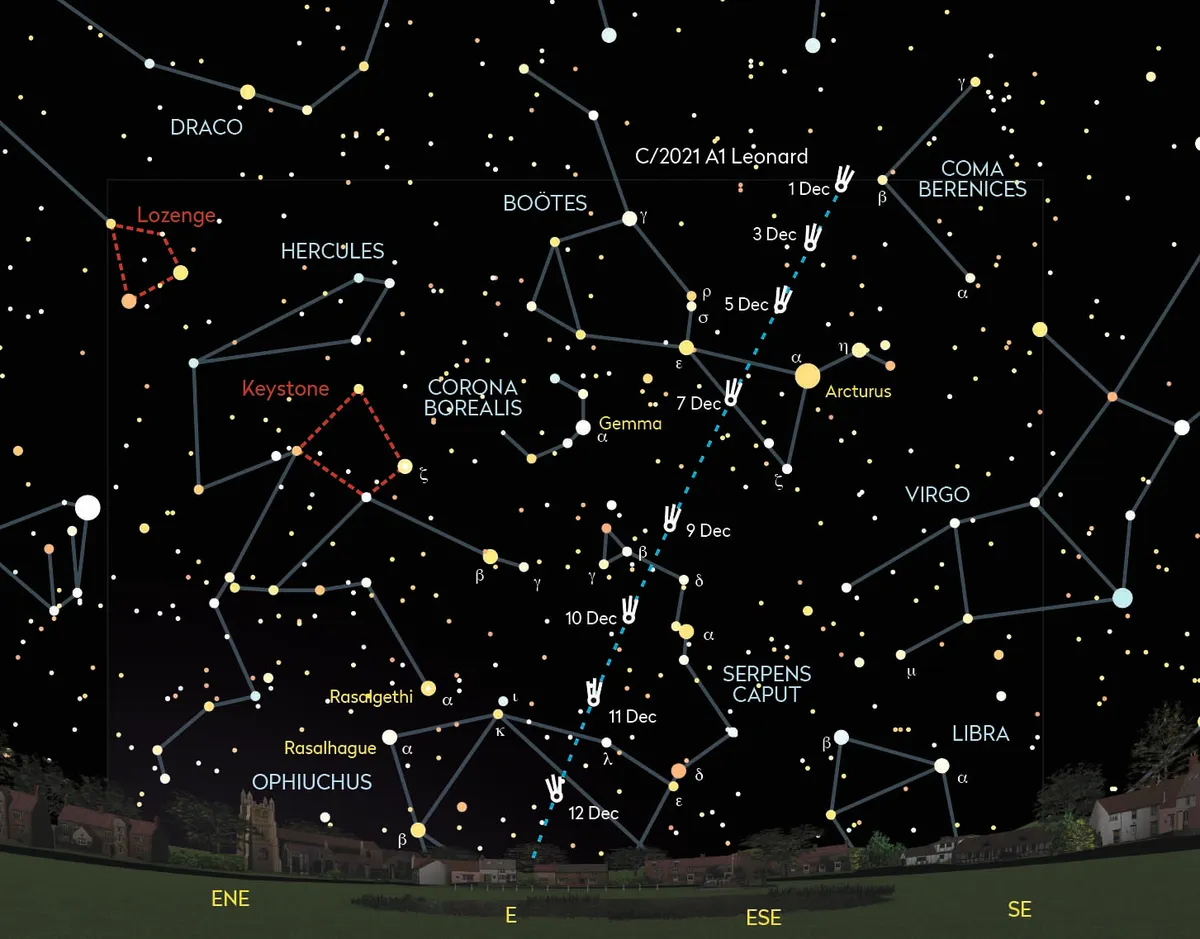
The best prospects of seeing Comet Leonard from the UK will be during the mornings of 1–13 December.
Its morning track is shown at the top of of this section, while just above we’ve shown how the comet moves relative to Venus in the evening sky.
Unless the comet brightens more than expected, the evening appearance will probably go unnoticed from the UK due to low altitude.
